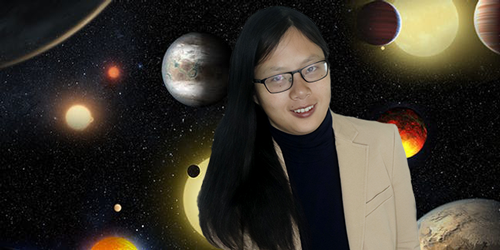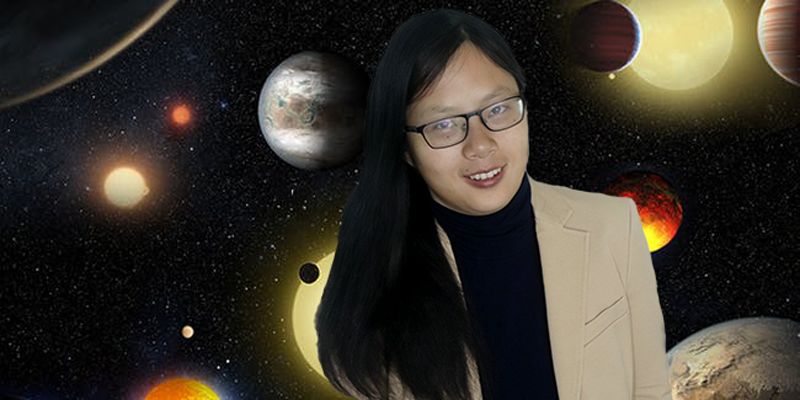Q&A: Hunting for Alien Worlds
Until 1995, there was no conclusive proof that any planet existed outside of our Solar System. Since then, scientists have discovered over 4000 exoplanets, with a wide range of orbits, sizes, atmospheres, and other traits. And astrophysicist Chelsea Huang of the MIT Kavli Institute for Astrophysics and Space Research has been at the heart of these planet hunting endeavors. She started her planet spotting career by contributing to the analysis of data collected from ground-based telescopes and from the Kepler satellite, a solar satellite that helped discover over 2600 exoplanets. Later, she joined the team for the Transiting Exoplanet Survey Satellite (TESS), which took over Kepler’s search for other worlds in 2018. Physics spoke to Huang to find out how she locates distant planets in satellite data, what planetary discoveries she hopes to make, and why she doesn’t expect to find Earth 2.0 anytime soon.
–Matteo Rini
How do you find new planets?
Planets are too faint to detect directly. Kepler and, now, TESS use an indirect technique called transit photometry. The method searches for dips in the measured brightness of a star, which can be caused by the crossing of a planet. The period and amplitude of these dips depend on a planet’s size and orbital period. Once the team finds a recurrent dimming signal, hinting at the presence of a planet, we follow up with observations from Earth-based telescopes to confirm the discovery and characterize other properties of the planet, such as its mass.
How are planets weighed?
A planet's orbit around a star causes the star to wobble slightly, with the amplitude of the wobble depending on the mass of the planet relative to the star. We can measure the wobble from the Doppler shift it induces in the wavelength of the star’s emitted light. From this shift, we determine the mass.
How many planets have you helped to discover and what do they look like?
To date, I’ve helped confirm 13 planet discoveries, and we have identified about 400 candidate planets. The first planet I found, Pi Mensae c, is twice as big as Earth—a “super-Earth”— and takes six days to orbit the star Pi Mensae, a yellow dwarf in a constellation close to the south celestial pole, 60 light years away from Earth. I’ve also spotted “hot Jupiters”—planets physically similar to Jupiter but much closer to their stars and thus hotter—and “mini-Neptunes,” which are slightly smaller than gas giants like Neptune but with a similar atmosphere and composition.
Kepler observed only 0.25% of the sky and mainly measured stars that were hundreds of light years away from Earth. TESS, instead, observes 85% of the sky and detects closer and brighter stars. That means that once we pinpoint a candidate planet with TESS, it’s easier to conduct follow-up observations with ground-based telescopes that can measure the planet’s mass and atmosphere. Three of the planets so far discovered using TESS lie within 100 light years of Earth. During its two-year mission, we expect TESS to find 20,000 new planets, among which a few hundred may have sizes comparable to or slightly bigger than Earth’s.
Do you hope to find Earth 2.0—an Earth-sized planet orbiting in the habitable zone of a Sun-like star?
Right now, we can’t find “Earth 2.0” because its orbit would likely be too long to be reliably spotted by TESS. The habitable zone consists of a range of orbits that allow liquid water to form on the planet’s surface. To be in the habitable zone of a Sun-like star, the planet’s orbit should, like Earth’s, last about one year, which is too long to extract from data taken over the planned two-year mission of TESS. If the survey gets extended, such observations may become possible.
But TESS can still help in finding and characterizing habitable planets. Red dwarfs, for example, weigh a fraction of the solar mass and are cooler. Planets in the habitable zone of a red dwarf will be closer to the star and thus have shorter orbits that TESS could detect. Those planets should also be close enough to Earth for us to characterize their atmospheres through spectroscopic studies. I’d be very excited to report the discovery of the first habitable planet orbiting a red dwarf.
What unsolved problem would you most like to address with your planet spotting?
Our Solar System contains small rocky worlds and giant gas planets. But we don’t yet know how these two planet types can form in the same planetary system. I’d like to help us understand that process. But for that we need to find many systems—perhaps at different stages of their development—that contain both planet types. And small planets are much harder to spot than giant ones. I am excited to work for TESS—the only game in town for doing that.
Does your job affect how you see the night sky?
During public observing events, people gaze through telescopes at stars and try to spot constellations. But when I look up, I see a sky teeming with invisible planets. I always suggest people try to imagine that.
Matteo Rini is the Deputy Editor of Physics.
Know a physicist with a knack for explaining their research to others? Write to physics@aps.org. All interviews are edited for brevity and clarity.
Correction (26 April 2019): The story has been updated to include Chelsea Huang’s current affiliation. This information was omitted in the original article.





